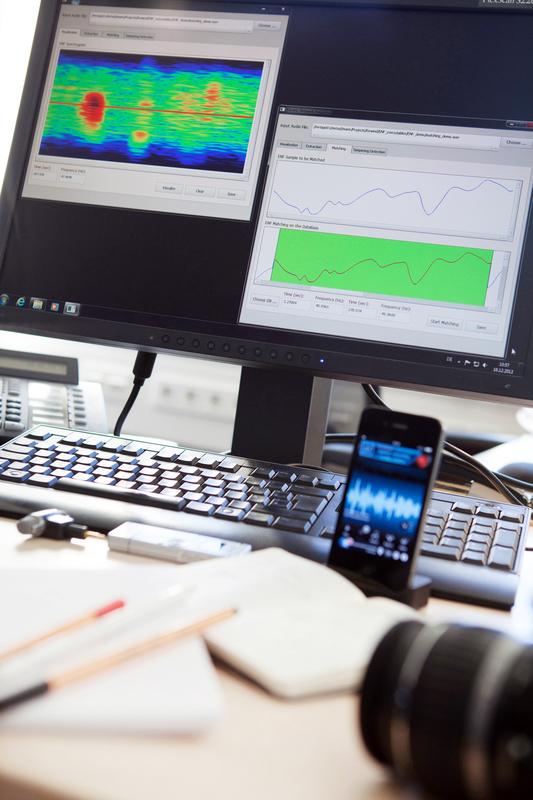No room for wrong notes

A look at how an editorial department might operate in the future – thanks to Fraunhofer software, journalists can verify the authenticity of an audio recording in a matter of seconds. Fraunhofer IDMT
“Here, this sort of event is greeted by silence,” says Christian Dittmar from the
Fraunhofer Institute for Digital Media Technology IDMT in Ilmenau. The software he has developed automatically detects plagiarized music and expunges the stolen parts of the song:
“In the most extreme cases, involving particularly brazen theft, there isn’t a single note left in the piece.” Fraunhofer IDMT’s “PlagiarismAnalyzer“ detects identical melodies and samples (whole portions of a song) in a matter of seconds. To do this, mathematical algorithms identify the tonal spectrum of the copy and the original and then compare the two.
Software detects manipulated audio material
Two audio recordings display their characteristic wave shape on the computer screen in front of Patrick Aichroth. An optical signal points to suspect points within the material. Dittmar’s colleague is also on the hunt for manipulated recordings. However, he is not just concerned with music but with audio files in general – including passages of speech recorded on smartphones. He and his team use a variety of techniques to detect manipulation, from electrical network frequency (ENF) analysis to microphone categori-zation and the inverse decoder.
“Editing processes such as cutting, encoding or decoding leave behind traces in the
audio file. These can be detected through an altered ENF, a change in the microphone
used or via the inverse decoder,” explains Aichroth. Fraunhofer IDMT developed the
inverse decoder on the basis of research findings from the Fraunhofer Institute for
Integrated Circuits IIS in Erlangen. The decoder shows which format and which para-meters were used to encode the original file – for instance the mp3 format, which
compresses the audio track.
It’s not just those examining cases of plagiarism that will be able to benefit from the
new technologies developed in Ilmenau. Editors, detectives and archivists are sure to
find it useful too as the flood of audio content on the internet and within companies
continues to rise. “These days, you don’t have to be an audio technician to make a
recording. Smartphones have become so widespread that audio recordings often exist
which might provide substantiating information on important events. As the amount of
audio content continues to rise, so too does the danger of manipulation – and there is
hardly ever time to check the recording manually,” says Aichroth.
To illustrate his point he cites two situations where automatically checking audio
material could prove extremely useful. The first involves an editorial team at a German
publication. Just before they are about to go to print, the journalists get hold of some
controversial audio material that would put a completely new spin on the title story.
The decisive question is whether the recordings are genuine.
Or imagine the following scene: the police possess several mobile phone recordings that heavily implicate the main suspect. Here too the officers need a speedy initial as-sessment of whether the recordings are genuine or whether they have been manipula-ted.
Fraunhofer’s scientists in Ilmenau developed their software as part of the EU-sponsored
REWIND project (http://www.rewindproject.eu). In this project Fraunhofer IDMT is
working alongside universities in Brazil, Italy, Spain and the UK. “We want to under-stand the basic theoretical principles and also to develop technologies from which
practical tools evolve. We are bringing together the strengths of all the technology
developed to date so that we can offer a quick analysis even for larger volumes of
data,” says Dittmar. It currently takes around 5 seconds to detect a 10-second original
sequence within a 30-second piece of music.
REWIND will be ending in April 2014. Shortly prior to this, from 10-14 March, 2014,
Fraunhofer IDMT will be showcasing results from the project at CeBIT in Hannover at
the Fraunhofer-Gesellschaft stand (Hall 9, Booth E40). Visitors to the stand will be able
to see for themselves how easily an audio file can be manipulated, how hard it is to tell
the difference by ear alone and how the tools developed in Ilmenau work in practice.
Media Contact
All latest news from the category: Communications Media
Engineering and research-driven innovations in the field of communications are addressed here, in addition to business developments in the field of media-wide communications.
innovations-report offers informative reports and articles related to interactive media, media management, digital television, E-business, online advertising and information and communications technologies.
Newest articles

“Nanostitches” enable lighter and tougher composite materials
In research that may lead to next-generation airplanes and spacecraft, MIT engineers used carbon nanotubes to prevent cracking in multilayered composites. To save on fuel and reduce aircraft emissions, engineers…

Trash to treasure
Researchers turn metal waste into catalyst for hydrogen. Scientists have found a way to transform metal waste into a highly efficient catalyst to make hydrogen from water, a discovery that…

Real-time detection of infectious disease viruses
… by searching for molecular fingerprinting. A research team consisting of Professor Kyoung-Duck Park and Taeyoung Moon and Huitae Joo, PhD candidates, from the Department of Physics at Pohang University…





















